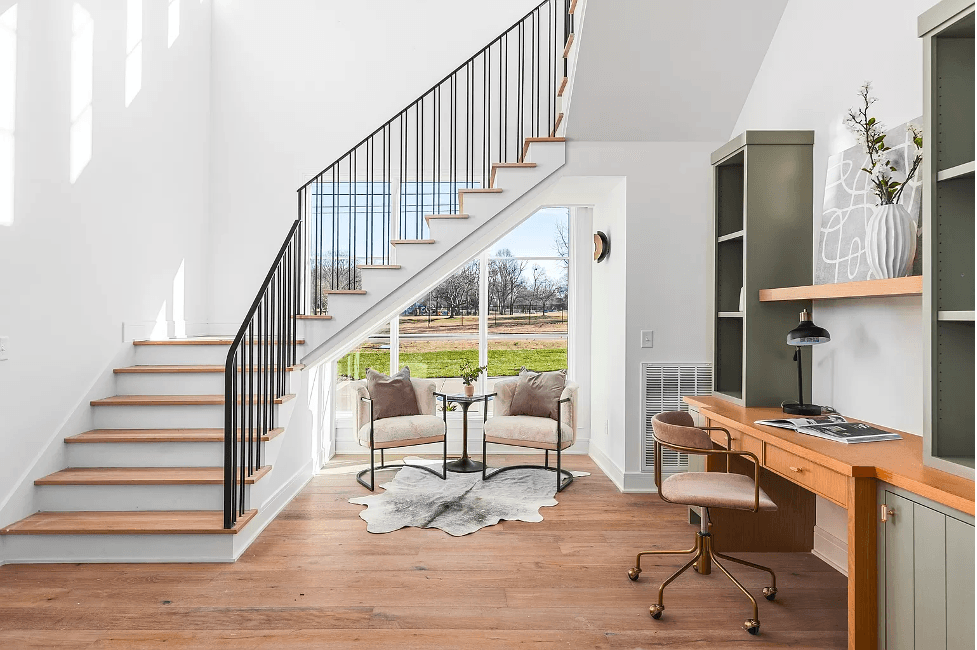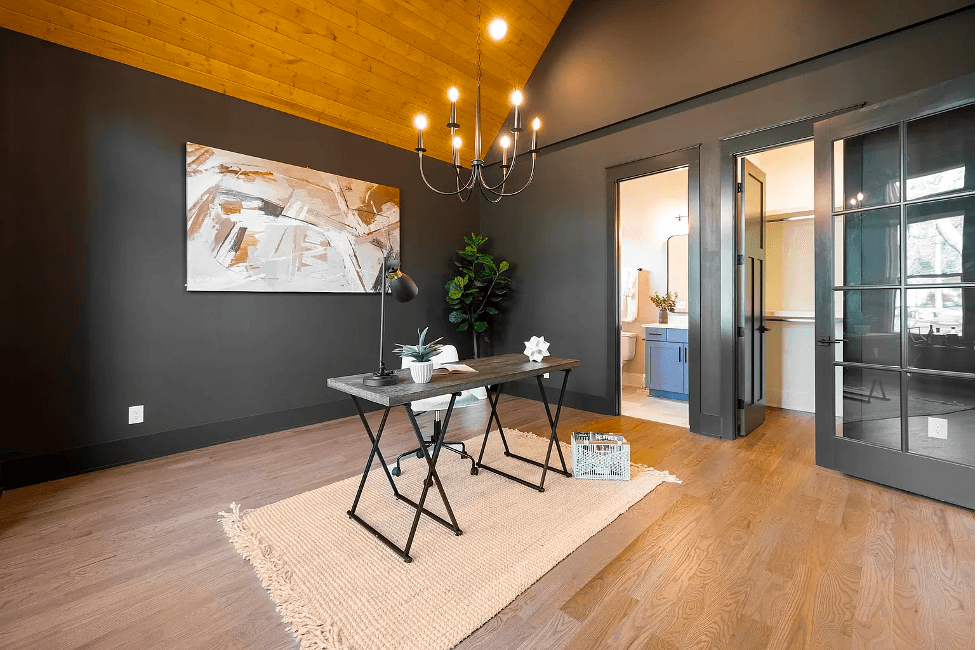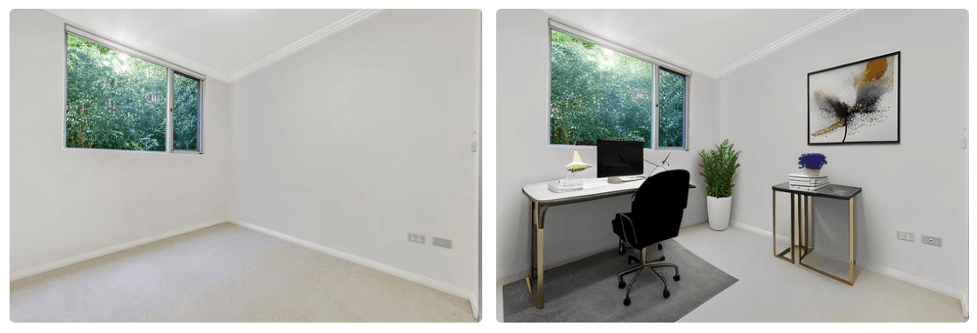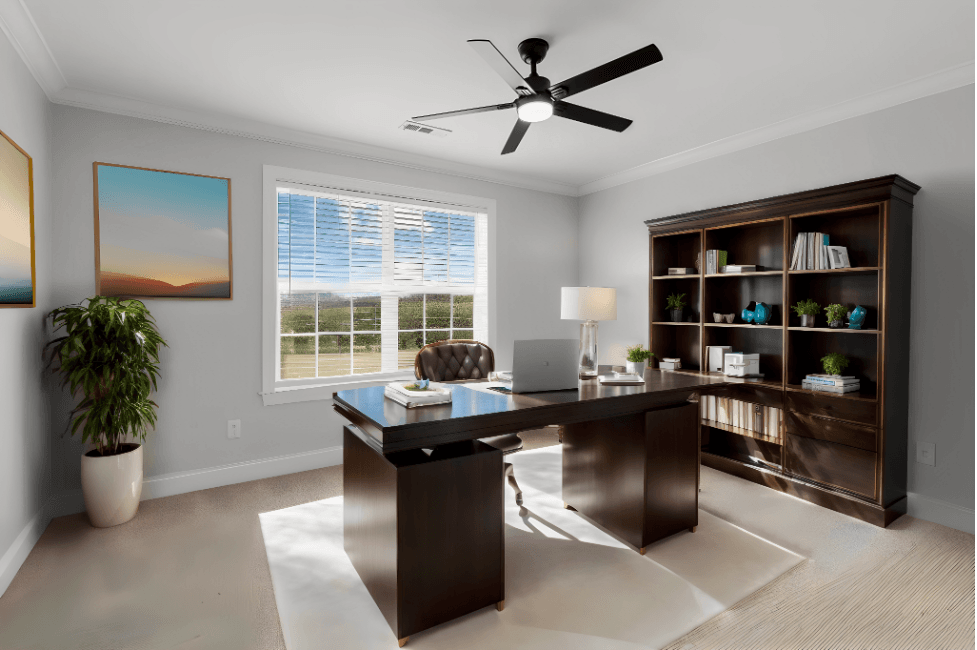January 4, 2024
How to Stage Your Home Office
As of January 2023, about 28% of full-time employees work in a hybrid arrangement (a few days in the office and a few days at home).
And around 36.2 million American employees are expected to work fully from home by 2025.
Many of these workers will be or are already doing so from their home offices.
So, if you’re thinking of selling your home, having an office space can give you a significant advantage over other sellers.
In fact, over 60% of buyers want a home office. Yet, only 39% of sellers’ agents stage a home office or office space.
In this article, we’ll cover why it’s so important to stage your home office to boost your home’s selling power and things to consider when designing the space.
Why You Should Stage Your Home Office
With the rise of work-from-home opportunities, it’s becoming more and more important for remote employees to have a designated area to work in.
In other words, many potential buyers are looking for homes with an office. Staging your office to make it more appealing to buyers can really give you an advantage over other homes.
Professional photography, decluttering, and depersonalizing your home office can make it easier for potential buyers to imagine themselves working in the space.
Plus, a bright, airy space with neutral colors can create a welcoming atmosphere. Meanwhile, investing in functional yet attractive office furniture can enhance the overall appeal of your home office.
Here’s an example of a professionally staged home office.

Can you picture yourself working from there? We can, too.
Office Space
Here are some tips and things to consider when staging your office area for potential buyers.
Maximize Floor and Vertical Space
In office spaces and other parts of our homes, we tend to cram our belongings horizontally, overcrowding shelves and cluttered surfaces.
But our homes offer vertical space that gives us the opportunity to reduce clutter and organize areas. Leverage every square inch of your home for the best results.
For example, if you don’t have a home office or a spare bedroom, you can take advantage of other free spaces in your home, such as alcoves, butler’s pantry, and loft areas.
Tucking your office into an alcove can help you save space and create a cozy spot for potential buyers to get some work done. Use space-saving furniture to avoid overcrowding the area.
If you have a basement, you can also use this area to create an office. This allows you to maximize the space you have available. And you don’t have to sacrifice another room, like your bedroom, for a defined work area.

Or, if you have a loft, you can leverage the natural nooks and crannies to design a workspace that seamlessly blends in with your home's unique architecture.
Use this tiny space to incorporate storage solutions, shelving, and ergonomic furniture to create a productive and visually appealing office environment.

Don’t have an alcove or loft? What about a butler’s pantry? You can incorporate your home office into a butler’s pantry design.
Consider using a desk with built-in cabinets or a fold-out work surface. For inspiration, check out this built-in workspace with plenty of storage. That way, it’s a functional office that’s still practical for organizing pantry items.
You can also use built-in shelves and cabinets to neatly store office supplies, files, and equipment. And use labeled containers to keep things organized.
For a sleeker design, consider sectioning off your office space with a sliding door, pocket door, or folding screen. That way, you can hide the office area when not in use and maintain the traditional butler’s area appearance.
And if you do have a specific room dedicated to a home office, you can maximize floor and vertical space by:
-
Investing in vertical storage units like tall bookshelves
-
Utilizing space under your desks or tables for storage
-
Using stackable storage shelves
-
Using wall-mounted shelves
-
Using a floating desk
Utilize Natural Light
Maximize natural light in your home office by opening drapes or blinds. You can also remove window treatments altogether to capture the sun’s beautiful rays during the day.
Consider adding mirrors to reflect and amplify natural light, which will help create the illusion of open space.
If natural light is lacking, you could use ceiling fixtures or floor lamps to brighten the room.
Neutral Colors
Neutral colors create an appealing atmosphere for buyers of different tastes and preferences. White, beige, and gray colors have a broad and timeless appeal and can even boost productivity levels.
A neutral backdrop also offers versatility, allowing buyers to integrate their own style and furniture into the space. In other words, certain colors make it easier for them to imagine how they’d personalize the space to suit their needs.
Balance Bright and Neutral Colors
But because neutrals are best doesn’t mean you can’t add other colors for visual interest.
Using bright colors in small bursts through accessories while keeping larger pieces in neutral tones creates the perfect balance of hues.

Choose a primary accent color to help you decide on other colors to incorporate into your office design and create a cohesive color palette.
For example, you can use neutral colors like warm white, cream, or soft gray. Complement these tones with calming colors like blue and green to create a relaxing environment.
Pops of Color for Interest
You can also incorporate pops of color into your office space. For example, you could use brightly colored furniture, decorative wall art, and vibrant plants.

These small details not only create visual interest but can also enhance the room’s overall atmosphere, boosting creativity and productivity.
Furniture and Accessories
Your home office furniture should be intentional. In other words, you should choose the pieces purposefully to optimize the space’s functionality, comfort, and design.
Desk Chair and Task Lighting Selection
When choosing between desk chairs, prioritize features like ergonomic design. Look for features that include adjustable seat height, lumbar support, and armrests.
But you don’t have to settle for ergonomic desk chairs if they don’t match your preferred aesthetic. Other popular desk chairs include:
-
Executive office chairs
-
High-back desk chairs
-
Leather desk chairs
-
Mesh desk chairs
-
Armless chairs

Task lighting is another factor to consider when figuring out how to stage a home office.
To ensure adequate lighting in the room, strategically place three light sources, including overhead lighting, a floor lamp, and a desk light.

Potted Plants or Fresh Flowers Add Life to the Room
Add life to your home office with potted plants or fresh flowers. Greenery can also fill empty spaces, give the space character and warmth, and make your home feel fresh and new.
Some of the best flowers and plants that are best for office staging purposes include:
-
Easy-care flowering plants such as peace lilies or succulents add color and freshness.
-
Seasonal flowers such as tulips or sunflowers add a pop of color and freshness.
-
Leafy plants like the fiddle leaf fig or snake plant for a timeless and versatile touch.
-
Classic flowers like peonies, hydrangeas, or lilies for a timeless and elegant touch.
-
Hanging plants like spider plants or cascading succulents add visual interest.
-
Tall plants like the areca palm or rubber plant for vertical interest.
Consider placing your greenery on your desk, shelves, bookcases, or near windows, or in empty corners.

These additions can appeal to all five buyers’ senses and make your home more inviting and memorable.
Storage Solutions for Personal Items
Like many homeowners, you may store extra items in your home office. Unfortunately, it can create a cluttered look.
To clear and declutter the area and provide a space to safely store your personal items while your home is being staged, use clear plastic bins, labeled boxes, or storage ottomans.
These storage solutions also keep personal items organized and out of sight, creating a clean and neutral space for potential buyers to imagine themselves in.
Try Virtual Staging AI as an Alternative
Traditional staging can be an overwhelming and stressful process. As a seller, you juggle different tasks like meeting with your listing agent, decluttering and personalizing each room, deep cleaning, making repairs, and more.
Staging is another thing to add to the list. From choosing the right furniture to swapping light fixtures, there’s a lot that goes into home staging.
And it isn’t as cost-effective as other options like virtual staging with AI. On average, hiring a professional stager can cost between $1,000 to $3,000.
Virtual staging, on the other hand, is a lot more cost-effective. For example, Virtual Staging AI’s monthly plans start at just $12.
Plus, virtual staging with AI is much more convenient. All you need is good lighting and a good-quality smartphone camera. And voila.
Here’s an example of a before-and-after home office. Which one do you prefer?

How does it work? Simply take a picture of the space and watch it transform into a fully furnished office in seconds.
No need to purchase or rent new furniture. No rearranging furniture. Most importantly, there’s no long turnaround. Get beautifully staged images in seconds. Choose from a variety of furniture styles, including:
-
Standard
-
Modern
-
Scandinavian
-
Industrial
-
Midcentury
-
Luxury
-
Coastal
-
Farmhouse
Here’s an example of a render with luxury furniture. Potential buyers will have no problem picturing themselves working in such a nice setting.

Stage Your Home Office for Success
There are quite a few elements that go into staging your home office for success.
Decluttering, incorporating neutral colors, using functional storage, adding pops of color, and ensuring prominent desk placement are just a few.
The results are well worth it. You can increase the value of your home and make it sell faster.
But as a homeowner who’s trying to find buyers, staging can be an overwhelming and expensive process.
Save time and money with virtual staging with AI. Try VSAI for free today.